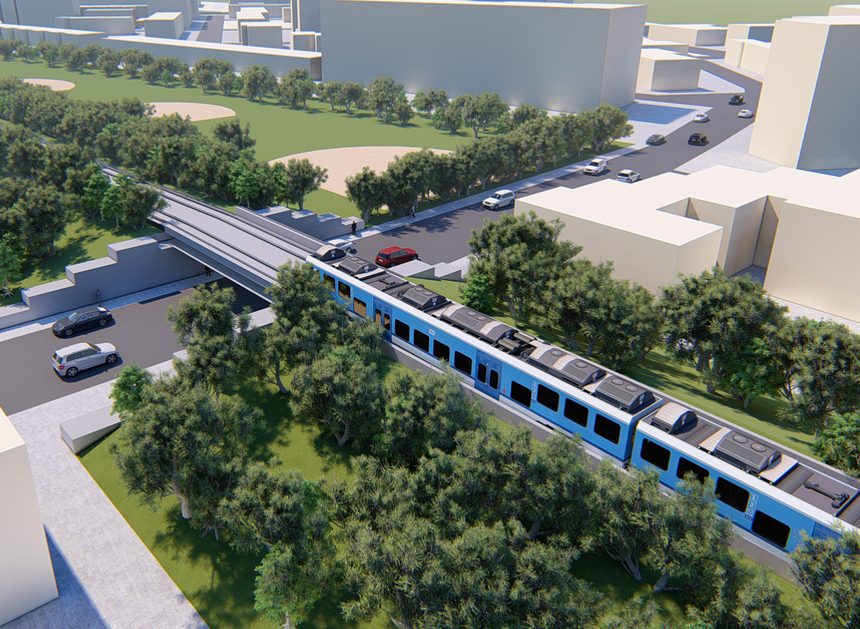City Council members have ramped up their attempt to get the Metropolitan Transportation Authority to do a deeper study of the QueensLink proposal to reactivate an old rail line that would provide better subway service for the southeast Queens desert.
QueensLink boosters and area politicians have for years lobbied state officials to revive 3.5 miles of deactivated tracks of the Long Island Rail Road's former Rockaway Beach Branch, which has been out of service since 1962. The proposal would extend the M train from Rego Park to the Rockaways, connecting an estimated 47,000 daily riders.
The added connection would get more Queens commuters out of their cars, provide a more direct route to Midtown Manhattan, and boost economic activity in neighborhoods with limited subway access, argued the two local pols behind the new bill, Council Member Joann Ariola and the Council's Transportation Committee Chair Selvena Brooks-Powers, both of southeastern Queens.
"We want this to be looked at," Ariola told Streetsblog. "I think it’s necessary and I think that it would really benefit the communities it would help if we push harder."
Politicians and community groups in an August letter already urged the MTA to do an environmental impact study of the rail idea.
The new legislation would be non-binding, and MTA officials said they don't plan to do a deep review right now, but Ariola hoped it would put more pressure on transit officials.
"What we want the MTA to know is that it’s not just a letter, it’s not just verbal support," the lawmaker said.
In an email with Streetsblog, Brooks-Powers said the Council bill goes beyond the letter.
"This resolution has been in the works and we wanted to introduce it ahead of the upcoming session in Albany [which begins in January] to signal this is a priority for me" as Transportation Committee chair, she said, adding that she has not heard back from the MTA regarding the August letter.
Mayor Adams in September has proposed the first step of the QueensWay conversion of right-of-way into a linear High Line-style park with $35 million for a study and initial construction between Rego Park and Ozone Park.

The Adams proposal miffed QueensLink advocates, who have pushed for the rail line for years, because they feared the greenway would derail their transit hopes, but MTA Chairperson and CEO Janno Lieber has said the park wouldn't preclude a rail expansion down the line. (The New York Times seems to favor the linear park.)
"We think [the Council bill] is a great step in the right direction," said QueensLink's Executive Director Rick Horan. "It may be more to send a message than any kind of legal requirement, but I think it’s a good first step toward taking this big decision and handling it in a rational way."
An MTA feasibility study released in 2019 found that reviving the railway branch would work, but could cost $8 billion. Hogan's group accused the agency of sandbagging the proposal with inflated costs and commissioned a report of their own, which concluded the project could be done for less than half that, between $3.4 and $3.7 billion.
The QueensLink report projected that the new transit option would create up to 150,000 new jobs, resulting in $13 billion increases in income and hiking property values along the corridor by as much as $75 billion.
The group's plan also includes up to 33 acres of space for parks, trails, and farmer’s markets along and underneath the railroad tracks
An MTA spokesperson said the new study is not needed as the agency is currently evaluating reactivating the project along with nearly two dozen proposals for more transit infrastructure as part of its long-term planning for future capital investments, also known as the 20-year Needs Assessment.
"At this time an Environmental Impact Statement is not necessary until the Comparative Evaluation process has concluded," said David Steckel. "We have been updating stakeholders of this and other projects subject to Comparative Evaluation as is appropriate including the Council member."
Horan said now was the time to get a better picture of how the rail line could work, as Governor Kathy Hochul is advancing the similar Interborough Express, which would build transit along an existing railroad corridor between Queens and Brooklyn.
The activist hoped a study would prompt Adams to hit the brakes on the QueensWay park plans, calling the idea of putting in green space before fully investigating a transit addition "reckless."
"To be spending taxpayer money to design a park on the exact same property that the MTA is studying for transit use is just reckless," said Horan. "This request for an EIS is basically saying let’s not use this for any other purpose until we’ve first totally exhausted studying it for transit use," Horan said.
Ariola maintained that the study wouldn't hinder the mayor's park plans.
“I don’t think that it would put the parks proposal on hold,” Ariola said. “There is enough land there to accommodate both."






